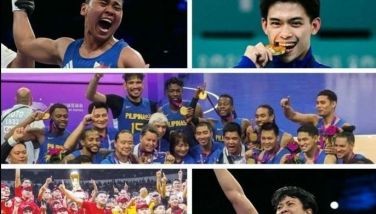Athletes in crossfire

June 26, 2003 | 12:00am
Philippine Olympic Committee (POC) president Celso Dayrit and Philippine Sports Commission (PSC) chairman Eric Buhain are at odds. So what else is new?
Fighting over turf has been a favorite pastime of the country’s sports officials since the abolition of Project Gintong Alay and the PSC’s creation in 1990. While the POC has the authority to select the national athletes for overseas competitions such as the Southeast Asian (SEA) Games, the Asian Games, and the Olympics, it is the PSC that finances the participation of the delegation.
The POC guards its autonomy like a precious treasure. The International Olympic Committee (IOC) prohibits government intervention in the affairs of a National Olympic Committee such as the POC. But with the PSC accountable for the funds it disburses, it’s difficult to blame the government agency for exercising some degree of supervision in tracking down how public money should be or is spent.
Theoretically, the POC and PSC should work together. After all, their objectives are the same–to promote Philippine sports and bring honor to the country.
It’s surprising that Dayrit and Buhain are on opposite sides because they’re both former national athletes and SEA Games medallists. Dayrit was a 1987 bronze medallist in fencing while Buhain splashed to five golds in swimming in 1991. They should know that athletes are caught in the crossfire when a war involving sports leaders erupts. They should know that their rift demoralizes athletes and causes serious repercussions in the development of national sports.
When there is dissension at the top, there is confusion at the bottom.
The problem blew up when Dayrit formed a POC task force to screen the athletes for eligibility to the SEA Games in Vietnam this December and the PSC claimed no representation. The PSC took an adversarial position and created its own task force to directly relate with the National Sports Associations (NSAs) without consulting the POC.
In setting the criteria for the selection of athletes for the SEA Games, the POC and PSC were philosophically miles apart. The POC is batting for maximum exposure with a target of at least 400. The PSC, citing a dwindling budget, is focusing on less than 300.
Dayrit said he’s looking beyond Vietnam. His vision is to screen potentials for the Athens Olympics next year and develop medallists for 2005 when the Philippines hosts the SEA Games.
Buhain, on the other hand, said with a limited budget, he can’t be too generous. Of course, he’d like to open the doors to as many athletes as possible but that’s a pipe dream. Realistically, the PSC can’t afford to spend a fortune in Vietnam.
The PSC’s standard for eligibility is based on past performance–at least a silver in the 2001 SEA Games or a bronze in the Asian Games last year. The POC’s standard allows for at least a bronze in the 2001 SEA Games or fifth place in the last Asian Games or a justifiable performance by teams in subjective sports and the potential to win by an athlete without sufficient credentials.
The PSC’s knee-jerk reaction to form its own task force is not only dysfunctional but also childish. Surely, Dayrit and Buhain can talk things over without either resorting to divisive tactics.
If Buhain’s problem is money, perhaps he can lay his cards on the table to Dayrit and set the maximum that the PSC can afford. If Dayrit wants to send more athletes than what the PSC can afford to spend for, then the POC should find other sources of funds. First Gentleman Mike Arroyo, for instance, has organized a personal foundation to provide assistance for athletes–he will certainly not turn his back on deserving athletes who would otherwise not be able to compete in Vietnam because of lack of resources.
Throwing brickbats at each other in the media won’t solve the problem that could escalate into a bitter feud. Dayrit and Buhain owe it to the country and their legacy as former national athletes to resolve their differences in a sportsmanlike manner. They shouldn’t lower themselves to the level of foul-mouthed fishwives.
The rift is symptomatic of the malaise that plagues Philippine sports.
There is no common vision that binds the public and private sectors in the development of sports. The development programs for the youth, students, and elite athletes are disjointed. Leaders aren’t on the same page when it comes to promoting sports. Some are tainted by hidden political agendas. Others are corrupted by money, cronyism, and the kamaganak syndrome.
The problem is systemic. Unless the POC is self-reliant, it can never enjoy absolute autonomy. And because the PSC is a government agency whose leadership is subject to changing political fortunes, it will always be a playground for transients vulnerable to abuse of authority and arrogance of power.
The sad reality is that while the country’s sports leaders quarrel over turf and money, the national athletes are left to drift in stormy waters. They are the victims of this silly squabble between two grown-men who refuse to act their age.
Fighting over turf has been a favorite pastime of the country’s sports officials since the abolition of Project Gintong Alay and the PSC’s creation in 1990. While the POC has the authority to select the national athletes for overseas competitions such as the Southeast Asian (SEA) Games, the Asian Games, and the Olympics, it is the PSC that finances the participation of the delegation.
The POC guards its autonomy like a precious treasure. The International Olympic Committee (IOC) prohibits government intervention in the affairs of a National Olympic Committee such as the POC. But with the PSC accountable for the funds it disburses, it’s difficult to blame the government agency for exercising some degree of supervision in tracking down how public money should be or is spent.
Theoretically, the POC and PSC should work together. After all, their objectives are the same–to promote Philippine sports and bring honor to the country.
It’s surprising that Dayrit and Buhain are on opposite sides because they’re both former national athletes and SEA Games medallists. Dayrit was a 1987 bronze medallist in fencing while Buhain splashed to five golds in swimming in 1991. They should know that athletes are caught in the crossfire when a war involving sports leaders erupts. They should know that their rift demoralizes athletes and causes serious repercussions in the development of national sports.
When there is dissension at the top, there is confusion at the bottom.
The problem blew up when Dayrit formed a POC task force to screen the athletes for eligibility to the SEA Games in Vietnam this December and the PSC claimed no representation. The PSC took an adversarial position and created its own task force to directly relate with the National Sports Associations (NSAs) without consulting the POC.
In setting the criteria for the selection of athletes for the SEA Games, the POC and PSC were philosophically miles apart. The POC is batting for maximum exposure with a target of at least 400. The PSC, citing a dwindling budget, is focusing on less than 300.
Dayrit said he’s looking beyond Vietnam. His vision is to screen potentials for the Athens Olympics next year and develop medallists for 2005 when the Philippines hosts the SEA Games.
Buhain, on the other hand, said with a limited budget, he can’t be too generous. Of course, he’d like to open the doors to as many athletes as possible but that’s a pipe dream. Realistically, the PSC can’t afford to spend a fortune in Vietnam.
The PSC’s standard for eligibility is based on past performance–at least a silver in the 2001 SEA Games or a bronze in the Asian Games last year. The POC’s standard allows for at least a bronze in the 2001 SEA Games or fifth place in the last Asian Games or a justifiable performance by teams in subjective sports and the potential to win by an athlete without sufficient credentials.
The PSC’s knee-jerk reaction to form its own task force is not only dysfunctional but also childish. Surely, Dayrit and Buhain can talk things over without either resorting to divisive tactics.
If Buhain’s problem is money, perhaps he can lay his cards on the table to Dayrit and set the maximum that the PSC can afford. If Dayrit wants to send more athletes than what the PSC can afford to spend for, then the POC should find other sources of funds. First Gentleman Mike Arroyo, for instance, has organized a personal foundation to provide assistance for athletes–he will certainly not turn his back on deserving athletes who would otherwise not be able to compete in Vietnam because of lack of resources.
Throwing brickbats at each other in the media won’t solve the problem that could escalate into a bitter feud. Dayrit and Buhain owe it to the country and their legacy as former national athletes to resolve their differences in a sportsmanlike manner. They shouldn’t lower themselves to the level of foul-mouthed fishwives.
The rift is symptomatic of the malaise that plagues Philippine sports.
There is no common vision that binds the public and private sectors in the development of sports. The development programs for the youth, students, and elite athletes are disjointed. Leaders aren’t on the same page when it comes to promoting sports. Some are tainted by hidden political agendas. Others are corrupted by money, cronyism, and the kamaganak syndrome.
The problem is systemic. Unless the POC is self-reliant, it can never enjoy absolute autonomy. And because the PSC is a government agency whose leadership is subject to changing political fortunes, it will always be a playground for transients vulnerable to abuse of authority and arrogance of power.
The sad reality is that while the country’s sports leaders quarrel over turf and money, the national athletes are left to drift in stormy waters. They are the victims of this silly squabble between two grown-men who refuse to act their age.
BrandSpace Articles
<
>
- Latest
- Trending
Trending
Latest
Trending
Latest
Recommended






























